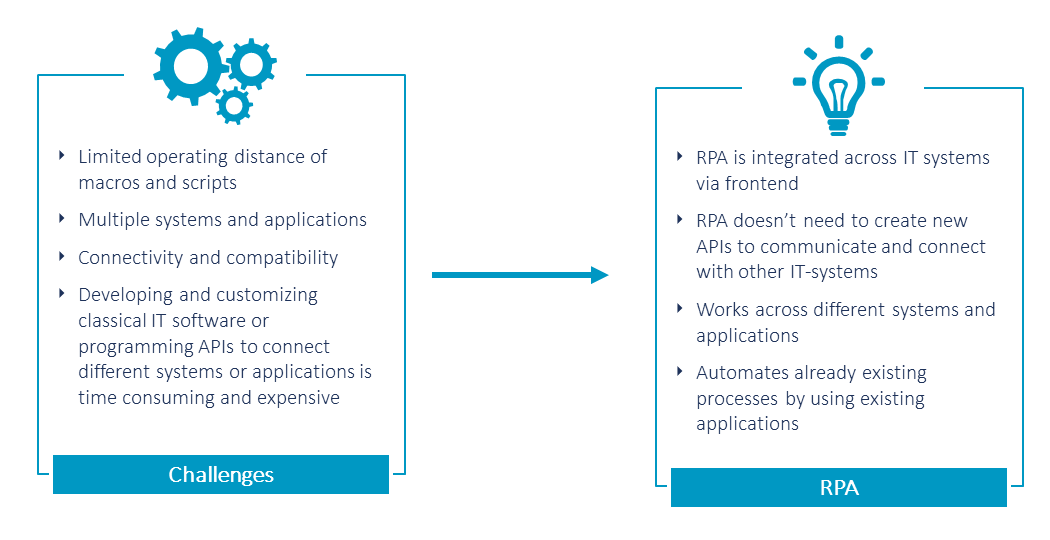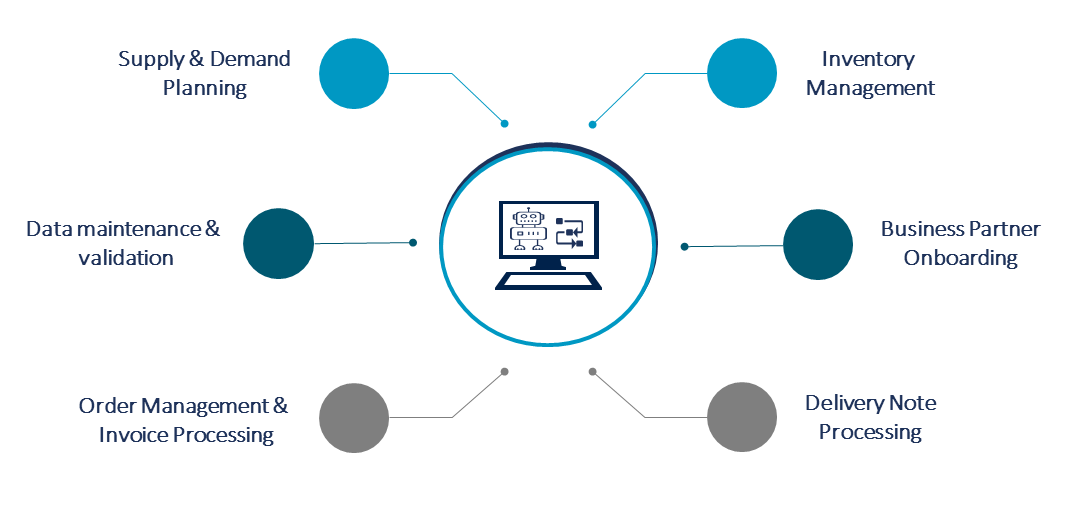This article provides a realistic path to automation within supply chain functions, demonstrating Robotic Process Automation (RPA) as a key enabler. As RPA fits perfectly for automating rule-based, repetitive and time-consuming tasks that previously had to be carried out manually, it can give an immense boost to process efficiency. But what are common use cases within supply chain functions and what could such a use case look like? We will provide insights on these questions and point out how RPA helps to overcome common challenges and pain points.
Top challenges and pain points for process automation
Within digital transformation, technologies play a major role, affecting all areas of an organization and changing traditional business processes and new business models. In this line, data integration and the automation of digital business processes often reveal unsolved challenges. Broken processes, low master data quality or missing digitization often pose major hurdles for the automation projects. In the context of hyperautomation, the overall goal of any digital transformation should be to combine concepts, technologies, and tools in the most effective way in order to achieve leaner and more efficient processes. RPA serves as a key enabler for automation by giving an answer to classical automation challenges as depicted in figure 1.
Figure 1: How RPA solves classical automation challenges of business processes
Solving these problems, RPA can lead to a comparable fast return on investment (ROI), if implemented correctly. No complex coding, no change in the existing IT-systems and no development of new APIs is required. In this way, RPA can enable a higher end-to-end automation by connecting different processes, loose part automations or data science solutions. Specifically, it means the interconnection and extension of already implemented but hitherto isolated data science solutions into greater synergic solutions with RPA as bridge and orchestration cockpit.
RPA use case areas within supply chain functions
One of the key benefits of RPA is that it can be applied to a wide variety of business processes along different industries and functions. Especially operational and transactional processes fit well for RPA, as these usually consist of highly manual, repetitive, and standardized tasks.
For example, RPA can be used for inventory management to inform a user or directly order new products whenever a minimum stock level is reached. Combined with machine learning, historical data could also be included to forecast the optimal inventory level and order quantity. Other common use case areas are order management & invoice processing, data maintenance & validation or an automatic supplier invoice status check. Figure 2 gives an overview of common use case areas within supply chain functions.
Figure 2: Exemplary use case areas within supply chain functions that can be automated through RPA
To get more information on how to select the most profitable processes for RPA, please visit our previous blog.
Detailed Use Case: Delivery note processing
Our client, a major specialized food producer, faced the ominous problem of paper-based documents. While in most cases of paper-based documents we apply process reengineering in order to substitute paper with more reliable digital tools, in this particular case the delivery note of liquid starting material had to be signed by the producer during weighing at clients’ site. This signed delivery note is then physically transmitted to the company’s department where all paper-based documents are scanned and sent to dedicated departments via e-mail.
At this point an employee (see Figure 3) from supply chain management (SCM) / logistics department is in charge, and downloads the delivery note from a shared mailbox. Once downloaded the employee opens the scan and searches for the relevant values and checks whether the maximum threshold for deviation on liquid material was exceeded. As it is common that there are deviations, the employee opens SAP in order to search for the delivery and starts comparing all data and corrects those that are incorrect. Finally, the employee concludes the delivery and attaches the scan to SAP.
In addition to repetitiveness and mundanity, the described “As-Is” process was highly manual, error prone and time-consuming. As the process was part of the Proof of Concept (PoC) for a larger project, the aim was to show quick results in a short period of time. The biggest challenges have been the scan quality (containment) and the fact that no process standards existed.
The client’s desire was to reduce processing time, to improve process quality as well as to reduce workload peaks and work backlogs. Furthermore, the employee satisfaction was part of the PoC in order to elevate interest in the business units.
Figure 3: Manual delivery note processing
Our solution was to apply the combination of RPA and Optical Character Recognition (OCR). While the OCR engine was placed at the core of the process and was combining pixels to characters by omitting signatures and handwritten corrections, RPA retrieved documents from multiple systems, moved it into the OCR engine and afterwards compared the results with the entries in the ERP system and applied corrections, if necessary.
As part of the PoC we aimed to work according to the 80/20 rule which means the RPA bot had still the possibility to redirect non-readable documents to an employee.
Figure 4: Automated delivery note processing
The result of the automated process was an unattended, standardized end-to-end process that reduced human errors and thereby increased data quality up to 30%. However, the greatest benefits were the reduced processing time by 50% and the scalability of the process in order to prevent workload peaks which liberated employees for creative and value-adding work.
What’s in for you?
Implementing RPA as a digital assistant to your employees can significantly increase process efficiency and shorten processing times. In addition, the employees can use the saved time for more value-adding tasks and the data quality can be increased due to less manual process errors and automatic consistency checks. As this is an exemplary use case, please keep in mind that it is always necessary to analyze, prioritize, optimize, and develop each single use case separately.
CAMELOT offers a holistic approach for RPA enterprise information management and can support organizations with our experience during different stages of exploration or implementation in the context of hyperautomation. For further information please get in touch with us.
The authors wish to thank Bhavana Jotwani, International expert for Value Chain Management for her contribution to this article.





